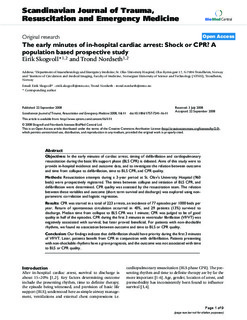The early minutes of in-hospital cardiac arrest: Shock or CPR? A population based prospective study
Journal article, Peer reviewed
Permanent lenke
http://hdl.handle.net/11250/2353169Utgivelsesdato
2008Metadata
Vis full innførselSamlinger
Originalversjon
Scandinavian Journal of Trauma, Resuscitation and Emergency Medicine 2008, 16(11) 10.1186/1757-7241-16-11Sammendrag
Objectives: In the early minutes of cardiac arrest, timing of defibrillation and cardiopulmonary
resuscitation during the basic life support phase (BLS CPR) is debated. Aims of this study were to
provide in-hospital incidence and outcome data, and to investigate the relation between outcome
and time from collapse to defibrillation, time to BLS CPR, and CPR quality.
Methods: Resuscitation attempts during a 3-year period at St. Olav's University Hospital (960
beds) were prospectively registered. The times between collapse and initiation of BLS CPR, and
defibrillation were determined. CPR quality was assessed by the resuscitation team. The relation
between these variables and outcome (short term survival and discharge) was explored using nonparametric
correlation and logistic regression.
Results: CPR was started in a total of 223 arrests, an incidence of 77 episodes per 1000 beds per
year. Return of spontaneous circulation occurred in 40%, and 29 patients (13%) survived to
discharge. Median time from collapse to BLS CPR was 1 minute; CPR was judged to be of good
quality in half of the episodes. CPR during the first 3 minutes in ventricular fibrillation (VF/VT) was
negatively associated with survival, but later proved beneficial. For patients with non-shockable
rhythms, we found no association between outcome and time to BLS or CPR quality.
Conclusion: Our findings indicate that defibrillation should have priority during the first 3 minutes
of VF/VT. Later, patients benefit from CPR in conjunction with defibrillation. Patients presenting
with non-shockable rhythms have a grave prognosis, and the outcome was not associated with time
to BLS or CPR quality.
